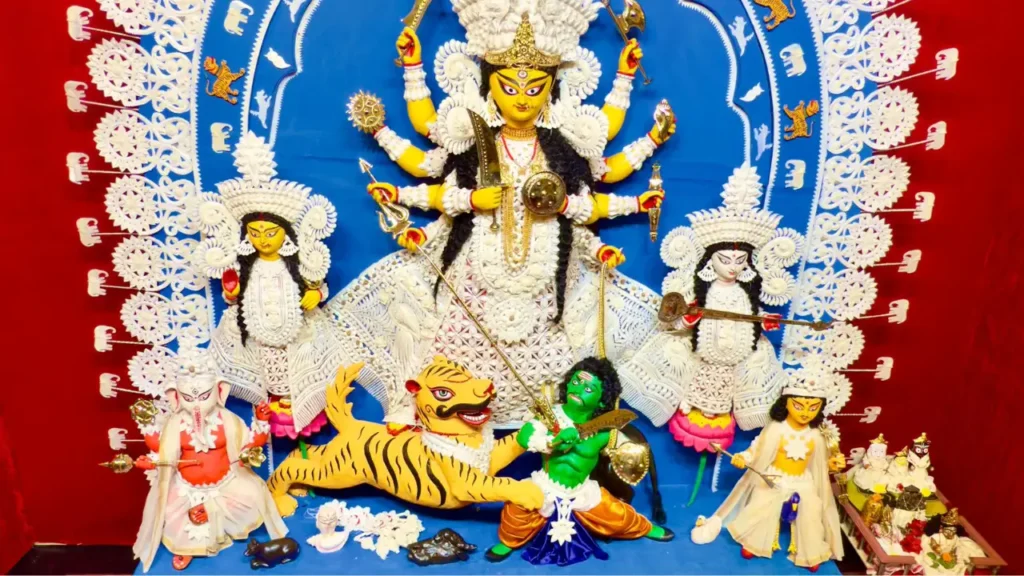Maa Durga
In a narrow lane of North Kolkata, a 180-year-old ancestral house prepares for Durga Puja with a quiet but profound difference. Across Bengal, Maa Durga is almost always shown riding a lion—the symbolic destroyer of evil. Yet here, she rides a tiger. Not as a deviation from faith, but as a declaration of identity. For this family, the goddess’s mount carries meaning far beyond myth.
Seventeen years ago, Joydip Kundu and his wife Suchandra decided to replace the lion in their idol with a tiger and named her Maa Byaghravahini—the goddess who rides the tiger. Their choice was rooted in conviction, not convenience. To them, the tiger represents both divine power and national responsibility: the essence of strength, patience, and resilience that India is rapidly losing in its wild.
While most Durga Puja committees compete for size and spectacle, this home remains serene, guided by purpose. Each year, local artisans from Kumartuli sculpt the tiger with meticulous care—its striped body taut, its expression fierce yet graceful. Visitors pause before the animal, almost forgetting the goddess for a moment. For Joydip, that pause is sacred; it reawakens empathy for a living being too often reduced to an image.
Maa Durga and the meaning of change
The inspiration, Joydip explains, comes from ancient texts where Maa Durga is described as Vyaghra-vahini—she who rides the tiger. Over centuries, artistic tradition replaced the tiger with a lion, perhaps because lions were easier to sculpt or aligned with royal symbolism. Yet, the tiger has always been India’s true predator, the silent guardian of its forests. By restoring the tiger beneath the goddess, this family restores memory to devotion.
In conversation, the couple speak of compassion as Durga’s truest weapon. They call it hypocrisy to worship her while ignoring the destruction of her companion’s habitat. The Sundarbans, home to Bengal’s tigers, continue to shrink under pressure from erosion, encroachment, and neglect. The couple hopes that when children see Maa Durga on a tiger, they will ask why the real animal is vanishing. Awareness begins with curiosity.
Across India, from government emblems to movie studios, lions dominate where tigers should stand. Each substitution erases something vital from cultural consciousness. The Kundu family’s Puja resists that erasure. It turns a festival into education—faith as activism.
This choice aligns with the growing push toward behavioral change—the idea that protecting wildlife requires altering human perception. Worship without awareness achieves nothing. Conservation depends on choices made at home, in rituals, and in the stories we tell our children. Culture can nurture conscience more effectively than policy. (Explore our cornerstone on behavioral change to see how social awareness strengthens tiger protection.)
Yet not everyone celebrates this symbolism. Some traditionalists call it “aesthetic interference.” Others say replacing the lion distorts religious continuity. But as Joydip often answers, “Change is not distortion—it’s remembrance.” His words echo through the narrow courtyard, where incense smoke mingles with the scent of clay and paint.
The family’s act also connects faith to science. Bengal’s tigers survive in fragile ecosystems like the Sundarbans, where rising tides and human intrusion threaten every cub. Their decision transforms an idol into a conversation. And conversation, in a country that too often treats the tiger as a poster or prop, is revolution enough.
International media have covered the story with admiration, calling it an example of how spirituality can serve conservation. (Read the original feature in Times Now News. )
Faith alone won’t save tigers, yet faith can reframe extinction as a moral question. When the goddess rides a tiger, not a lion, belief itself becomes defiance—a reminder that India’s spiritual identity and its ecological survival are inseparable.
Seventeen years of Maa Durga as Byaghravahini prove that conservation isn’t just policy—it’s personal. It’s art, prayer, and the courage to remember what the forest has lost.






